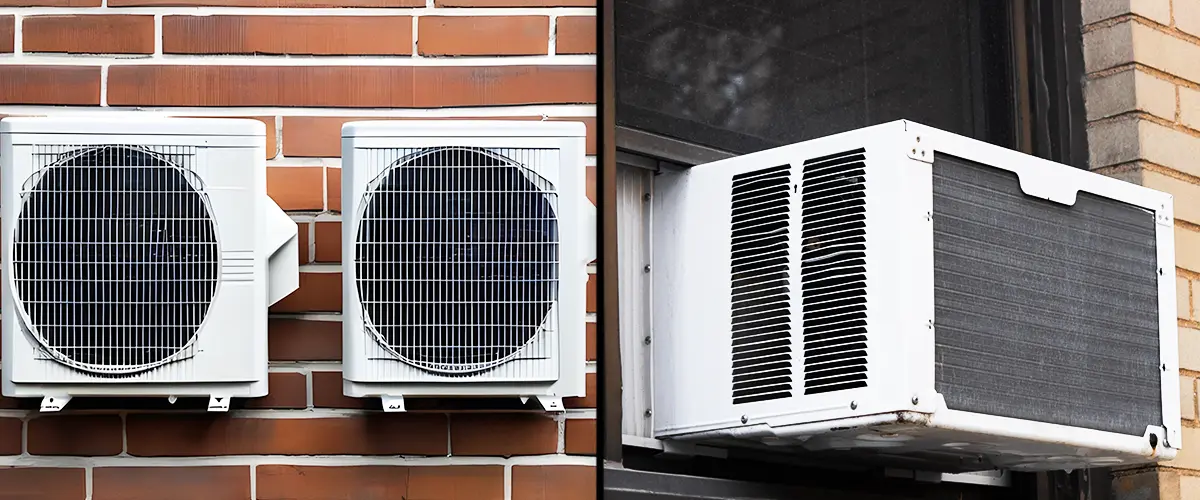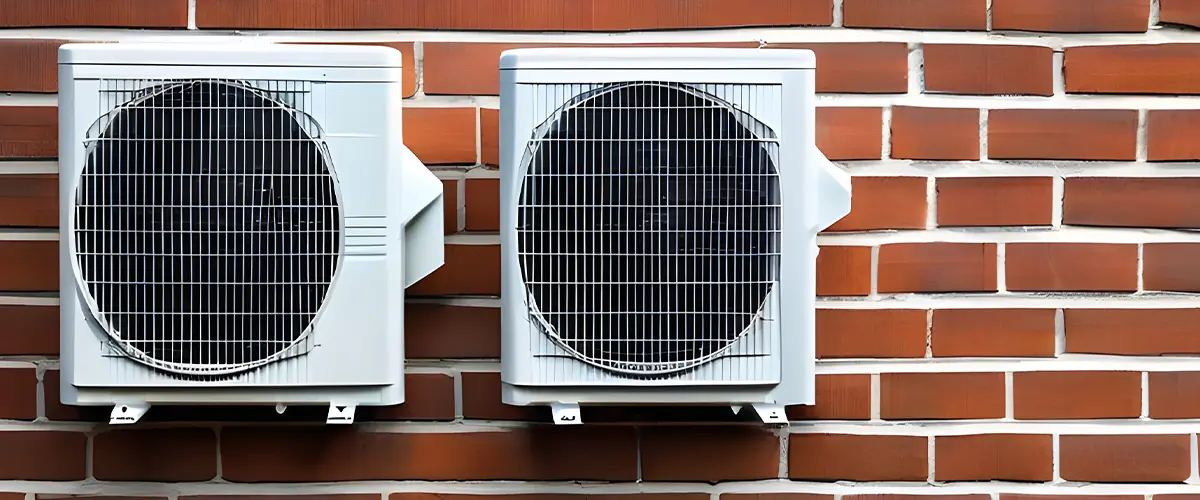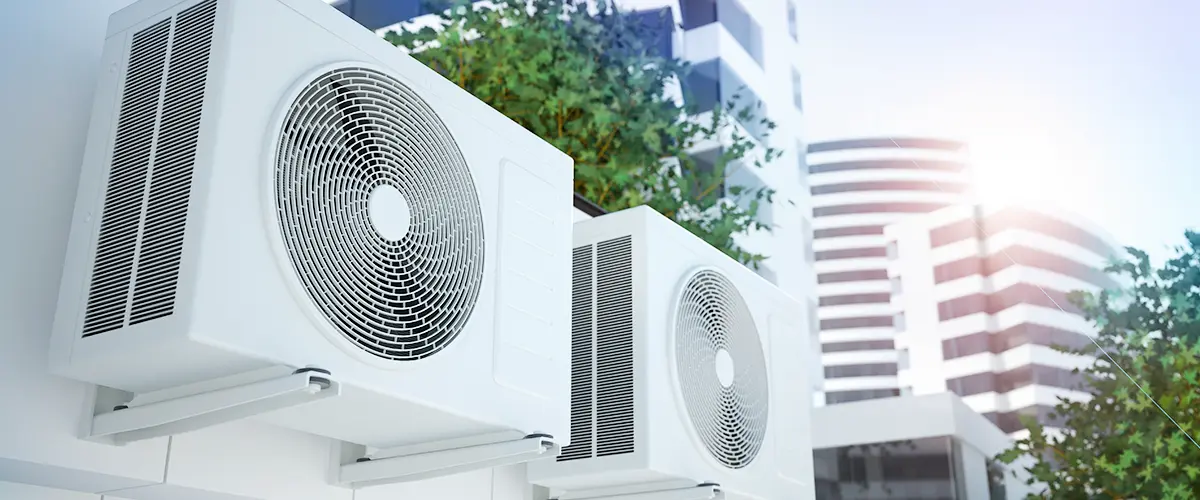Mini Split Vs Window Unit: Buyers Guide
Deciding between a mini split vs window unit can be tricky for many homeowners. Did you know that the choice could significantly impact your home’s comfort and energy bills? This guide will compare mini splits and window air conditioners, breaking down everything from installation costs to efficiency.
Find out which cooling system is right for your needs.

Key Takeaways
- Mini split systems can cool and heat multiple rooms, making them versatile all year. They are energy efficient but cost more upfront.
- Window units are cheaper and easier to install but only cool one room at a time. They may increase energy bills because they're not as efficient.
- Both types need regular maintenance like filter cleaning for optimal performance.
- Room size matters when choosing between the two; mini splits cover larger areas while window units are good for small spaces.
- Consider installation costs and whether you need both cooling and heating before deciding.
Understanding the Differences Between Mini Split and Window Units
- Capacity and coverage of Mini Split and Window Air Conditioning Units
Mini split systems offer a flexible solution for cooling and heating multiple rooms or zones in a home. They consist of an outdoor unit connected to one or more indoor units, allowing homeowners to control the temperature in individual rooms.
This setup can cover a larger area effectively since each indoor unit operates independently. Mini splits are ideal for homes without ductwork and can be used to cool entire homes by installing multiple indoor units.
Window AC units, on the other hand, are designed for cooling single rooms. Installed in a window frame, they’re easier to set up but have limitations in cooling capacity and coverage area.
A window AC is suitable for small rooms and is less effective in open spaces or large areas. For homeowners looking to cool several rooms, this would mean installing multiple window AC units throughout the home, which could impact natural light and aesthetics.
- Costs of Mini Split Units vs Window units
Mini split air conditioners often have higher upfront costs due to the need for professional installation and the purchase of an outdoor compressor unit along with one or more indoor air handling units.
These systems, however, can lead to lower utility bills over time because of their energy efficiency. Mini splits use advanced technology like inverter technology which allows them to adjust power usage based on the cooling needs, making them more energy efficient.
Window units cost less initially and do not typically require professional installation unless there is a need for significant modifications to the window or wall. Despite their lower initial price, window air conditioning units might not be as energy efficient as mini splits, potentially resulting in higher electricity costs during peak cooling seasons.
They also tend to cool only one room effectively.
- Cooling vs. heating and cooling
Efficiency in cooling is vital, but what about heating when the weather turns chilly? Mini split units can cool and heat rooms, making them versatile for year-round comfort. On the other hand, window units primarily provide cooling with only a few models offering heating capabilities.
It’s important to consider whether you need both functions or just cooling when deciding between the two options. For homeowners seeking a comprehensive climate control solution that includes both heating and cooling, mini split units may be the ideal choice.
Mini split systems are known for their ability to cool individual rooms efficiently while also providing effective heating during colder months. Conversely, window units focus predominantly on cooling and may not offer the same level of versatility for homes requiring both functions.
When evaluating your needs as a homeowner, assessing whether you require only cooling or both heating and cooling will play a significant role in determining which system best suits your requirements.
- Maintenance
Regular maintenance is crucial for both mini split and window units to guarantee efficient operation. For mini splits, this entails cleaning or replacing the filters every 1-3 months to uphold air quality and system efficiency.
Moreover, scheduling annual professional maintenance, including coil and pipe cleaning, is key to keeping the system running smoothly. Conversely, window units necessitate regular filter cleaning and outdoor condenser maintenance as part of routine upkeep to ensure optimal performance in cooling your space efficiently.
By giving priority to regular maintenance for either type of unit, you can significantly prolong their lifespan while maximizing energy savings – ultimately ensuring that you get the most out of your investment in a reliable cooling system for your home.
- Efficiency
Ductless mini split systems excel in efficiency, consuming less energy than window units for the same amount of cooling. This efficiency stems from their design that facilitates accurate temperature control in various areas of your home without squandering energy on unoccupied areas.
Mini splits possess sophisticated features like inverter technology which modulates power use according to requirements, resulting in considerable energy conservation.
Despite the initial affordability of window units, they often result in inflated electricity bills over time. They simply can’t rival the specific cooling and heating provided by ductless systems.
Moreover, inadequate humidity control with window units might degrade the comfort level of your living space. If long-term energy cost savings matter to you, a ductless mini split system may be a more sensible decision.
Factors to Consider When Choosing Between Mini Split and Window Units

- Room size
When choosing between a mini split and window unit, consider the size of your room. Mini splits are ideal for cooling individual rooms or large areas, with their capacity ranging from 9,000 to 36,000 British Thermal Units (BTUs).
They can efficiently cool rooms up to 1,500 square feet. On the other hand, window units are suitable for smaller spaces and can typically cool areas ranging from 100 to 650 square feet with capacities around 5,000 to 18,000 BTUs.
Installation cost should be taken into account when considering room size. A larger room may require multiple window units compared to just one mini split system for effective cooling.
Therefore, depending on the dimensions of your space and coverage required, the suitability of each system varies significantly.
- Installation cost
When deciding between a mini split and window unit, it’s important to consider the installation cost. Mini splits typically cost more upfront due to their complexity and the need for a professional installation.
On the other hand, window units are generally less expensive and can often be installed by homeowners without the need for professional help. Factors such as the number of units needed and any additional electrical work required can also impact installation costs.
For many homeowners, the decision ultimately comes down to finding an affordable option that meets their cooling needs while staying within budget constraints. Understanding these factors will help you make an informed decision that aligns with your financial considerations when selecting between mini split and window units.
- Overall functionality
When considering a mini split versus a window unit for your home, take into account the overall functionality. Mini splits offer quiet operation with remote controls, while window units provide quick cooling but may be louder.
Moreover, mini splits are tailored to improve multiple zones in large rooms, while window units may have difficulty effectively cooling larger spaces due to their limited capacity and coverage.
Take into account the square footage of your room when assessing overall functionality. Mini splits can efficiently cover more square footage, making them suitable for larger areas.
Conversely, window units might be more practical for smaller spaces due to their lower installation costs and ease of maintenance.
Pros and Cons of Mini Split and Window Units
Mini Split: Pros and Cons
| Pros of Mini Split Units | Consof of Mini Split Units |
|---|---|
| Improved Energy Efficiency: Mini-split systems often boast higher SEER (Seasonal Energy Efficiency Ratio) ratings than traditional window units, leading to lower electricity bills. | Higher Initial Cost: The upfront cost for mini-split systems can be significantly higher compared to window units, including equipment and installation fees. |
| Versatile Installation Options: These systems do not require a window, offering more flexibility in terms of placement and preserving the aesthetic of your home's exterior. | Professional Installation Required: Installing mini-split systems typically involves a certified technician, adding to the overall cost and planning considerations. |
| Heating and Cooling: Most mini-split units come with both heating and cooling functions, making them a versatile option for year-round climate control. | Complexity in Multi-Room Solutions: For homes needing multiple units, the complexity and cost can increase, especially when requiring units for several rooms. |
| Quiet Operation: Mini-split systems are known for their quiet performance, enhancing indoor comfort without the disruptive noise associated with some window units. | Aesthetic Impact: The indoor and outdoor components, while sleek, may not seamlessly integrate into every home’s design, potentially impacting the visual appeal. |
| Minimal Maintenance: These systems generally require less maintenance than window units, with simple filter cleaning and occasional checks from a technician. | Repairs and Servicing: When issues do arise, servicing mini-splits might require specialized knowledge, potentially leading to higher maintenance costs over time. |
Window Units: Pros and Cons
| Pros of Window Units | Cons of Window Units |
|---|---|
| Affordable upfront cost | Can be noisy during operation |
| Simple installation process | May block natural light and views |
| Portable and can be moved from room to room | Limited cooling capacity, ideal for smaller rooms only |
| No need for major home modifications | Potential security risk if not installed properly |
| Energy efficient models available | May not aesthetically blend with home exterior |

Best Manufacturers of Mini Split and Window Units
- Mitsubishi Electric: Known for advanced technology and high energy efficiency, particularly in multi-zone systems.
- Daikin: Offers a wide range of options with innovative features and exceptional performance for varied climates.
- LG: Provides stylish designs and reliable performance, with a focus on smart technology integration.
- Friedrich: Specialises in window air conditioners, known for durability and superior cooling capacity in compact spaces.
- Samsung: Combines modern aesthetics with advanced tech, delivering energy-efficient solutions for residential and commercial use.
FAQs
Poor humidity control can make both types of cooling systems less effective. It might not cool as efficiently and could lead to issues with the heat pump in some cases.
Experience You Can Trust
Our team has been providing top-notch cooling system services for years, ensuring professional results that save you money in the long run. If you live in California and you’re ready to tackle your home remodeling project with industry experts, contact us at (626) 598-0833 to get started.
